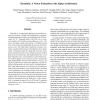Free Online Productivity Tools
i2Speak
i2Symbol
i2OCR
iTex2Img
iWeb2Print
iWeb2Shot
i2Type
iPdf2Split
iPdf2Merge
i2Bopomofo
i2Arabic
i2Style
i2Image
i2PDF
iLatex2Rtf
Sci2ools
93
Voted
ISCA
2002
IEEE
2002
IEEE
Tarantula: A Vector Extension to the Alpha Architecture
Tarantula is an aggressive floating point machine targeted at technical, scientific and bioinformatics workloads, originally planned as a follow-on candidate to the EV8 processor [6, 5]. Tarantula adds to the EV8 core a vector unit capable of 32 double-precision flops per cycle. The vector unit fetches data directly from a 16 MByte second level cache with a peak bandwidth of sixty four 64-bit values per cycle. The whole chip is backed by a memory controller capable of delivering over 64 GBytes/s of raw bandwidth. Tarantula extends the Alpha ISA with new vector instructions that operate on new architectural state. Salient features of the architecture and implementation are: (1) it fully integrates into a virtual-memory cache-coherent system without changes to its coherency protocol, (2) provides high bandwidth for non-unit stride memory accesses, (3) supports gather/scatter instructions efficiently, (4) fully integrates with the EV8 core with a narrow, streamlined interface, rather...
Hardware | ISCA 2002 | Peak Bandwidth | Tarantula | Vector Unit |
| Added | 15 Jul 2010 |
| Updated | 15 Jul 2010 |
| Type | Conference |
| Year | 2002 |
| Where | ISCA |
| Authors | Roger Espasa, Federico Ardanaz, Julio Gago, Roger Gramunt, Isaac Hernandez, Toni Juan, Joel S. Emer, Stephen Felix, P. Geoffrey Lowney, Matthew Mattina, André Seznec |
Comments (0)

